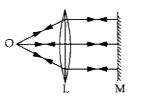For a plane mirror what is the focal length? The magnification?
To solve the question regarding the focal length and magnification of a plane mirror, we can follow these steps:
Step 1: Understanding Focal Length of a Plane Mirror
A plane mirror reflects light rays that are parallel to each other. Unlike concave or convex mirrors, where light rays converge or diverge, the rays reflected from a plane mirror do not converge to a point. Instead, they remain parallel after reflection.
Conclusion: The focal length (f) of a plane mirror is considered to be infinity (∞) because the reflected rays do not meet at a focal point.
Step 2: Understanding Magnification of a Plane Mirror
Magnification (m) is defined as the ratio of the height of the image (h') to the height of the object (h). For a plane mirror, the image formed is virtual, upright, and of the same size as the object.
The formula for magnification is given by:
m=h′h
Since the height of the image is equal to the height of the object in a plane mirror, we can write:
m=hh=1
Conclusion: The magnification of a plane mirror is 1, indicating that the image size is equal to the object size.
Final Answers:
- Focal Length of Plane Mirror: ∞ (infinity)
- Magnification of Plane Mirror: 1
---
A plane mirror reflects light rays that are parallel to each other. Unlike concave or convex mirrors, where light rays converge or diverge, the rays reflected from a plane mirror do not converge to a point. Instead, they remain parallel after reflection.
Magnification (m) is defined as the ratio of the height of the image (h') to the height of the object (h). For a plane mirror, the image formed is virtual, upright, and of the same size as the object.
m=h′h
m=hh=1
- Focal Length of Plane Mirror: ∞ (infinity)
- Magnification of Plane Mirror: 1
Topper's Solved these Questions
- BOOK - AAKASH SERIESCHAPTER - RAY OPTICSEXERCISE - PROBLEMS ( LEVEL-I)57videos
RAY OPTICS
- BOOK - AAKASH SERIESCHAPTER - RAY OPTICSEXERCISE - PROBLEMS ( LEVEL-II)60videos
RAY OPTICS
- BOOK - AAKASH SERIESCHAPTER - RAY OPTICSEXERCISE - EXERCISE (SHORT ANSWER QUESTIONS )24videos
RAY OPTICS
- BOOK - AAKASH SERIESCHAPTER - PRACTICAL PHYSICSEXERCISE - LECTURE SHEET LEVEL-II (ADVANCED) Linked Comprehension Type Questions4videos
PRACTICAL PHYSICS
- BOOK - AAKASH SERIESCHAPTER - SEMICONDUCTOR DEVICESEXERCISE - EXERCISE - III3videos
SEMICONDUCTOR DEVICES
Similar Questions
Where should an object be placed in front of a concave mirror of focal length 15 cm to have a magnification of 3 in case of
(a) real image
(b) virtual image ?View SolutionA beam of light converges towards a point O, behind a convex mirror of focal length 20cm.
Q. Find the magnification and nature of the image when point O is 10cm behind the mirror.View SolutionThe image of an object placed on the principal axis of a concave mirror of focal length 12 cm is formed at a point which is 10cm more distance form the mirror than the object. The magnification of the image is
View SolutionAt what distance from his face a person should place concave mirror of focal length 0.4 m so that magnification is 5 times for a virtual image?
View SolutionThe radius of curvature of a plane mirror of focal length 40cm is :
View SolutionAn object is placed in front of a concave mirror at a distance of 7.5 cm from it. If the real image is formed at a distance of 30 cm from the mirror, find the focal length of the mirror. What would be the focal length if the image is virtual.
View SolutionThe given ray diagram illustrates the experimental set up for the determination of the focal length of a converging lens using a plane mirror.

state the magnification of the image formed .View SolutionFor an object placed at a distance 20 cm from a concave mirror, the image is formed at the same position. What is the focal length of the mirror?
View SolutionAn object of length 4 cm is placed in front of a concave mirror at distance 30 cm. The focal length of mirror is 15 cm. a. Where will the image form? B. What will be the length of image?
View SolutionMagnitude of focal length of a spherical mirror is f and magnitude of linear magnification is 12
View Solution

